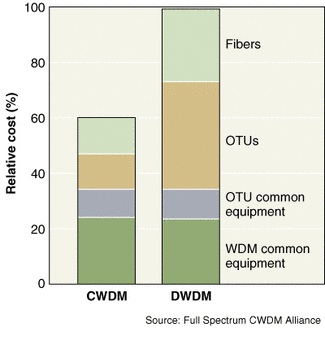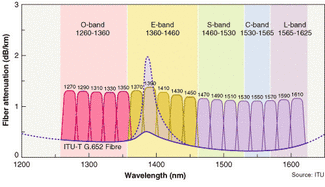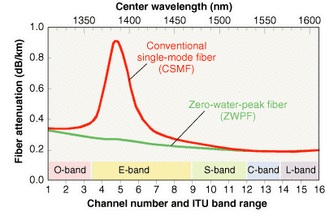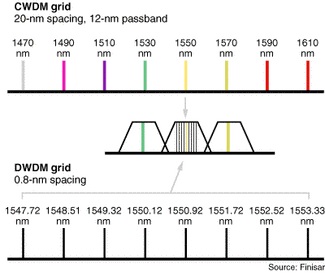
Long considered the less sophisticated cousin to dense wavelength-division multiplexing (DWDM), coarse wavelength-division multiplexing (CWDM) is emerging as one of the few revenue opportunities in telecommunications and data communications these days. With cost considerations now at the forefront of carrier investment in optical networks, the CWDM infrastructure offers several advantages over DWDM—even beyond the standard 50- to 80-km distances usually associated with CWDM.
The very characteristics that make DWDM attractive for long-haul applications—primarily the ability to significantly increase the bandwidth of a single fiber and offer hundreds of transmission channels in the process—also make it much more complex and expensive than CWDM. With carrier attention turning away from the saturated long-haul market, CWDM has gained new respect as carriers seek simpler and more cost-effective network solutions for the metro, access, cable TV (CATV), and enterprise markets (for more on CATV see p. 65). In addition to seeing increasing sales, CWDM component suppliers say that CWDM is becoming a universal standard, with growing adoption in Europe, Asia, and North America.
Coarse WDM technologies have actually been in use since the early 1980s, primarily in 850-nm multimode local area network (LAN) applications.1 But in the late 1990s, spurred by increasing bandwidth demands and a growing need to ease data traffic bottlenecks in metro, access, and enterprise networks, carriers began turning to CWDM as a lower-cost alternative to DWDM for a broad range of multipurpose, multimode applications, including local-, wide-, and storage-area networks. According to various market reports, the estimated cost savings of CWDM systems over DWDM systems varies from 35% to 65% .

"It is well documented that the reason there was a gap in the metro/access bandwidth space was that the users of the hardware were waiting for a solution that made sense so they could sell the bandwidth and make money," said Harvey Spreckman, director of sales for Tsunami Optics (Mountain View, CA), which was founded in early 2000 by a group of DWDM veterans interested in developing CWDM-specific products. "The vendors who were trying to sell DWDM into that space weren't getting orders because the math didn't make sense."
Metro networks have requirements very different from those of long-haul networks, including more fiber availability, the need to support a wider range of protocols, and stricter cost considerations. When it became apparent that CWDM offered advantages over DWDM for metro applications, several vendors began re-engineering their WDM technologies to provide a range of wavelengths more suited to metro transmission requirements —at about one-third the cost.
"[Initially], people were trying to force-fit DWDM components into applications that were demanding a more elegant solution for metro and access networks based upon exploiting the benefits of uncooled lasers," Spreckman said. "Uncooled lasers basically drift over the entire operating range of the equipment, cutting out a lot of the cost, complexity, and even size of the hardware used to transmit signals."

As defined by the International Telecommunications Union (ITU-T, G.694.2), CWDM wavelengths cover the 1270- to 1610-nm range in 20-nm increments (see Fig. 2). The most commonly used groups are from 1510 to 1570 nm for 4 wavelengths, 1470 to 1610 nm for 8 wavelengths, and 1310 to 1610 nm for 16 wavelengths. In comparison, DWDM devices operate in the much narrower 1530 to 1570-nm wavelength range and require 10 to 15 W and multiple power-supply voltages to temperature-stabilize the wavelength.2 Because CWDM intrinsically lends itself to short-distance applications—utilizing uncooled distributed-feedback (DFB) lasers and thin-film filters—there is no need for the thermoelectric coolers, expensive dispersion compensators, or erbium-doped fiber amplifiers that characterize DWDM systems in long-haul installations.
Other advantages of CWDM include simpler thin-film filter design, less power consumption, and less stringent alignment requirements. All of this translates into smaller, more-affordable packages, and efforts are now under way to further reduce the size of CWDM components and increase the reliability and scalability of CWDM networks.
"What will make CWDM win is two things: cost and standardization," said Pat Edsell, president of Gigabit Optics (Sunnyvale, CA), which recently introduced a miniature mux/demux for CWDM applications (see Fig. 3). "CWDM is significantly cheaper than DWDM, which should make it a winner in the metro core. Standardization will not only help keep the cost of CWDM systems down but will allow customers to mix and match subsystems from different vendors. There is very little standardization in DWDM subsystems, so customers are pretty much tied to a single supplier."
One of the most important technological advances contributing to the adoption of CWDM has been the development of low- and zero-water-peak fiber (ZWPF). Conventional single-mode fiber suffers from excess water-peak attenuation between 1350 and 1450 nm, making this band unusable for signal transmission (see Fig. 4). In addition, single-mode fiber can carry only 12 channels or less, depending on the tail of the water peak and excess hydrogen aging loss over time.

In contrast, ZWPF permanently eliminates the hydroxyl peak, resulting in low loss at 1400 nm and offering up to 33% more CWDM capacity than single-mode fiber-based systems. In addition to increasing the number of available CWDM channels, ZWPF lower the cost of deploying CWDM systems in metro networks.3
Leading the charge in the development of ZWPF has been OFS (Norcross, GA). Introduced in 1998, the OFS AllWave fiber is the industry's first fiber designed for optimum performance in local/access metro networks. AllWave fiber offers the same dispersion as conventional single-mode fiber but with reduced loss and zero water-peak in the 1400-nm water-peak band. This enables the use of extra bandwidth equivalent to 100 DWDM channels. With 20-nm grid spacing, at least 16-channel CWDM transmission is possible for ZWPF in the full spectrum region, from 1310 to 1610 nm.
"Prior to 2002, there existed only 8-channel CWDM systems," said Santanu Das, director of metro applications and CATV for OFS (Norcross, GA) and chair of the Full Spectrum CWDM Alliance. "But 2002 was a breakthrough year, and companies are now supplying the G.652.C low-water-peak fibers and offering the electronics to utilize the full spectrum."
For all its strengths, however, CWDM does have one fundamental drawback—the use of uncooled DFB lasers without amplifiers limits the reach of a CWDM network to around 80 km. Semiconductor amplifiers suited to CWDM are being developed; last September, Transmode Systems (Stockholm, Sweden) and Vitesse Networks (Hertford, England) performed a successful field trial of an amplified CWDM system over 200 km that involved linear optical amplifiers (LOAs) from Genoa (Fremont, CA). In that trial, four CWDM channels of Gigabit Ethernet were transmitted over 125 km of fiber by using one LOA as booster. According to the companies, by adding an additional LOA, the transmission reach could be increased to 200 km. There are concerns, however, that this approach will increase the cost of CWDM to a point at which it becomes less competitive with DWDM.
"Right now, CWDM is capable of 60 to 80 km easily and there is amplifier technology around the corner that will double this to 125 to 160 km, but they are expensive," Das said. "So what are the stronger points of DWDM that CWDM might do?"
Thus, efforts are now under way to combine CWDM and DWDM for some applications, retaining the less-expensive features of the CWDM infrastructure while exploiting the overlapping DWDM channels within CWDM (1531 and 1551 nm, in the C-band) to expand the network's reach. For example, Finisar (Sunnyvale, CA) has offered pluggable optics for CWDM since 1999 and just last June introduced a pluggable DWDM transceiver that is intended to improve the scalability of CWDM. According to Jim Aldridge, senior marketing manager for WDM products at Finisar, the advent of ZWPF has enabled CWDM to scale up to 16 wavelengths in the 1290 to 1610-nm spectrum.4 But if traffic growth on a CWDM network begins to exceed 16 wavelengths, it will be possible to scale bandwidth even further by adding DWDM to the network ring (see Fig. 5).

Similarly, Microsense (Hamm, Germany) now offers a modular optical multiplexer that allows a soft migration from CWDM to DWDM. Initially the multiplexer offers up to 8 CWDM channels, but when capacities need to be expanded, each individual CWDM channel can be scaled up to 8 DWDM channels, allowing up to 64 optical channels altogether.
"CWDM does provide a 'pay as you go' strategy so that as you upgrade in capacity with a full-spectrum fiber, you can get up to 16 channels," said Paul Dickinson, technical manager, customer systems engineering at OFS. "Major vendors like Cisco have shown that if customers need more than 16 channels, they can overlay the CWDM in the DWDM slots to increase the channels. And this is going to delay the need to expand into DWDM tremendously by providing more CWDM channels per fiber."
M. Miller et al., Proc. 9th Intl. Fiber Optic Comm. and Local Area Networks Expo, 107, (San Francisco CA; Sept.18-20, 1985).
F. Levinson, WDM Solutions, 9, (January 2003).
C. Ufongene, R. Boncek, WDM Solutions, 12 (November 2002).
J. Aldridge, Lightwave Europe (September 2002).